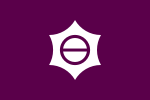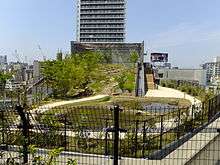Meguro
| Meguro 目黒区 | ||
|---|---|---|
| Special ward | ||
| Meguro City | ||
.jpg) Cherry trees along the Meguro River, near Nakameguro | ||
| ||
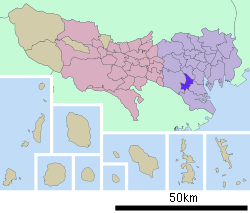 Location of Meguro in Tokyo Metropolis | ||
 Meguro Location in Japan | ||
| Coordinates: 35°38′N 139°41′E / 35.633°N 139.683°ECoordinates: 35°38′N 139°41′E / 35.633°N 139.683°E | ||
| Country | Japan | |
| Region | Kantō | |
| Prefecture | Tokyo Metropolis | |
| Government | ||
| • Mayor | Eiji Aoki | |
| Area | ||
| • Total | 14.67 km2 (5.66 sq mi) | |
| Population (May 1, 2015) | ||
| • Total | 277,171 | |
| • Density | 18,890/km2 (48,900/sq mi) | |
| Symbols | ||
| • Tree | Castanopsis | |
| • Flower | Lespedeza | |
| • Bird | Great tit | |
| Time zone | UTC+9 (JST) | |
| Website |
www | |
Meguro (目黒区 Meguro-ku, "Black Eye") is a special ward in Tokyo, Japan. The English translation of its Japanese self-designation is Meguro City.[1][2] The ward was founded on March 15, 1947.
Meguro is predominantly residential in character, but is also home to light industry, corporate head offices, the Komaba campus of University of Tokyo as well as fifteen foreign embassies and consulates. Residential neighborhoods include, Jiyugaoka, Kakinokizaka, and Nakameguro. As of May 1, 2015, the ward has an estimated population of 277,171 and a population density of 18,890 persons per km2. The total area is 14.67 km2.
Meguro is also used to refer to the area around Meguro Station, which is not located in Meguro ward, but in neighboring Shinagawa's Kamiōsaki district.
History
The Higashiyama shell mound in the north of the ward contains remains from the paleolithic, Jōmon, Yayoi, and Kofun periods.
The area now known as Meguro was formerly two towns, Meguro proper and Hibusuma, all parts of the former Ebara District of Musashi Province. The two were merged into a Meguro ward for Tokyo City in 1932 and since then the ward has remained with no alterations to its territory.
The name "Meguro", meaning "black eyes", derives from the Meguro Fudō (Black-eyed Fudō-myōō) of Ryūsenji. The Meguro Fudō was one of five Fudō-myōō statues placed at strategic points on the outskirts of Edo in the early seventeenth century by the abbot Tenkai, an advisor to Tokugawa Ieyasu, to provide protection for the new capital of the Tokugawa shogunate.[3] Each statue had eyes of a different color. (Mejiro, a district in Toshima ward, is named for the white-eyed Fudō-myōō).
Geography
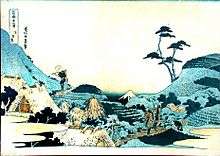
Four other special wards surround Meguro. They are Shibuya (to the northeast), Setagaya (to the west), Ōta (to the south), and Shinagawa (to the southeast).
Districts
Meguro area
- Aobadai
- Ōhashi
- Kamimeguro
- Gohongi
- Komaba
- Shimomeguro
- Nakachō
- Nakameguro
- Higashiyama
- Mita
- Meguro
- Yūtenji
Hibusuma area
- Ōokayama
- Kakinokizaka
- Jiyūgaoka
- Senzoku
- Tairamachi
- Takaban
- Chūōchō
- Nakane
- Haramachi
- Higashigaoka
- Himonya
- Midorigaoka
- Minami
- Megurohonchō
- Yakumo
Politics and government
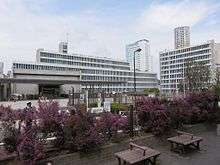
Meguro ward government is led by the city assembly with 36 elected members with current terms from May 1, 2011 to April 30, 2015. The chairman of the council is Yoshiaki Ito. The mayor is Eiji Aoki, an independent. His term lasts until April 24, 2016.
Elections
Sightseeing and local landmarks


Green spaces
- Meguro River
- Komaba Park, Komaba
- Komabano Park, Komaba
- Komazawa Olympic Park
- Meguro Sky Garden, Ohashi Linear roof garden park spiraling 35 meters above street level covering the junction of two major expressways.
- Saigoyama Park, Aobadai
- Sugekari Park, Aobadai
- Nakameguro Park and Nature Center
- Himonya Park, Himonya
Cultural institutions
- Tokyo Metropolitan Museum of Photography
- Meguro Museum of Art, Tokyo
- Meguro Persimmon Hall, concert and performance arts venue[4]
- Meguro Parasitological Museum
- Japanese Folk Crafts Museum
- Chosenin Temple Contemporary Sculpture Museum
Religious institutions
Transportation
Rail
- Tokyu Corporation
- Tōyoko Line: Naka-Meguro, Yutenji, Gakugei Daigaku, Toritsu Daigaku, Jiyugaoka Stations
- Ōimachi Line: Jiyugaoka, Midorigaoka, Ōokayama Stations
- Meguro Line: Ōokayama, Senzoku Stations
- Den-en-toshi Line: Ikejiri-Ōhashi Station
- Keio Corporation Keiō Inokashira Line: Komaba-Todaimae Station
- Note: Meguro Station (JR East, Tokyu Meguro Line, Tokyo Metro Namboku Line, Toei Mita Line) is in Shinagawa, not Meguro.
Highways
- Route 3 (Shuto Expressway) Shibuya radial route (Tanimachi JCT – Yoga)
- Central Circular Route C2. Completed in 2016 this deep level subterranean expressway connect the Yamate Tunnel as far as the Bayshore Route in Shinagawa
Education
Colleges and universities
- University of Tokyo Komaba Campus
- Tokyo Institute of Technology
- Note: Tokyo Gakugei University and Tokyo Metropolitan University were formerly in Meguro.
Public schools
Public elementary and junior high schools are operated by the Meguro City Board of Education. Public high schools are operated by the Tokyo Metropolitan Government Board of Education.
- Geijutsu High School
- International High School (Kokusai High School in Japanese)
- Komaba High School
- Meguro High School
In addition the metropolis operates a consolidated junior and senior high school called Ōshūkan Secondary School.
International schools
Economy
Companies
- Unilever Japan, head office
- Amazon Japan head office
- Walt Disney Japan, head office
- Books Kinokuniya[8]
- Don Quijote discount store chain head office
- TopTour Corporation
- New Japan Pro Wrestling head office
- Ribera Steakhouse
- Makino[9]
- LDH (Headquarters for EXILE & other Dance Units)
Notable people from Meguro
- Yumiko Fujita, actress
- Waka Inoue, model, actress
- Toru Iwatani, arcade game designer, most notable for Pac-Man and Pole Position
- Shigeru Izumiya, folk singer, entertainer
- Masako, Crown Princess of Japan
- Yukio Sakaguchi, mixed martial arts fighter and professional wrestler
- Kazuo Tokumitsu, television presenter
Notable residents
- Takuya Kimura, singer and actor in male idol group SMAP
- Shizuka Kudo, popular singer and wife of Takuya Kimura
- Keisuke Kuwata, singer with Southern All Stars
- Nobuyo Ōyama, voices the cartoon character Doraemon
- Miyu Uehara, gravure idol, found dead in her Meguro apartment.
- Halca & Yucali of the hip-hop duo Halcali[10]
- Sato Shori, singer and actor in male idol group Sexy Zone
- Suehiro Maruo, Manga artist, one of the best-known exponents of Ero Guro
References
- ↑ "目黒区方式ホームページ (Official Homepage of Meguro City, Japanese)". Retrieved 2011-04-26.
- ↑ "English: Meguro City (Official English webpage for Meguro City)". Meguro City. Archived from the original on 2008-11-03.
- ↑ Paul Waley, Tokyo: City of Stories (Tokyo: Weatherhill, 1991), 237.
- ↑ "トップページ ― めぐろパーシモンホール/中目黒GTプラザホール". Persimmon.or.jp. Retrieved 2014-04-07.
- ↑ "Himonya Catholic Church". Home.m06.itscom.net. Retrieved 2014-04-07.
- ↑ "Katholische Deutschsprachige Gemeinde". Sankt Michael Tokyo. Retrieved 23 April 2014.
- ↑ "日本聖公会東京教区聖パウロ教会". Nskk.org. Retrieved 2014-04-07.
- ↑ "Headquarters & Main Contacts Archived 2011-08-03 at the Wayback Machine.." Books Kinokuniya. Retrieved on July 25, 2011. "Dept.General Affairs Dept. 3-7-10 Shimomeguro Meguro-ku, Tokyo 153-8504"
- ↑ "." Makino. Retrieved on November 16, 2013. "Makino Milling Machine Co. Ltd. 3-19, Nakane 2-chome, Meguro-ku, Tokyo 152, Japan"
- ↑ http://www.yucali.jp/
External links
| Wikimedia Commons has media related to Meguro. |
| Wikivoyage has a travel guide for Meguro. |
- Meguro City Official Website (in Japanese)
